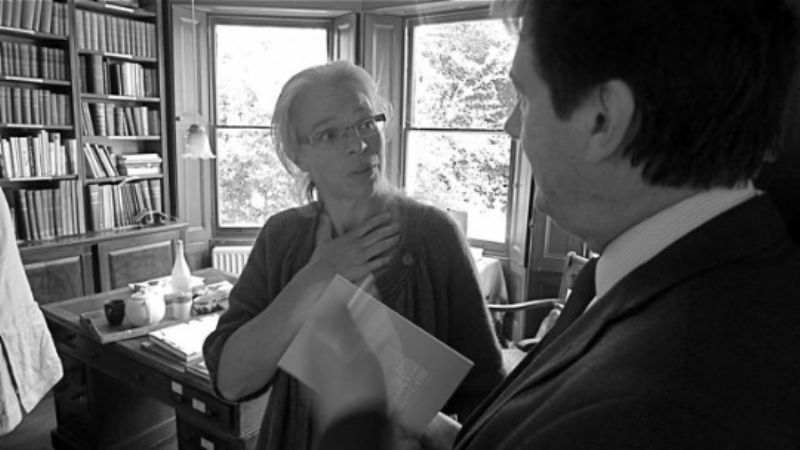 Inside the South London Botanical Institute
Inside the South London Botanical Institute  Garden 1
Garden 1  Garden 2
Garden 2  Nature Room
Nature Room  Halina and Ian
Halina and Ian
Took a minicab across to Tulse Hill this morning, with a driver who had been one of Vietnam’s Boat People. He was part of a group of people trying to leave the country in 1979, but they got into difficulties and split up at the quay, so he was the only one of his family group that got onto the boats. The rest of his family apparently ended up in re-education camps for two years. Like the Afghani driver who drove me across to Volans with a set of pictures a couple of weeks ago, a man who had fought alongside the Russians, my Vietnamese driver says he was very well treated by the British immigration authorities when he got here.
Finding the South East Botanical Institute proved a little mystifying, but the driver stuck with the task – and the morning was beautiful. I was on my way to chair a meeting of the Trustees of the Foundation for Democracy and Sustainable Development (FDSD), but had sadly missed the first half day yesterday, because of my last-moment trip to Vevey. Luckily, Ian Christie, as Deputy Chair, has stepped in.
As a result of my Vevey jaunt, I had missed two outbound Trustees, Tim O’Donovan (who had been with the Environment Foundation since the get-go) and Jane Nelson (who had joined alongside Sir Geoffrey Chandler when I took over as Chairman, deep in the mists of pre-history). Dr Malcolm Aickin (another Trustee who had been there from the beginning, indeed from before that) did make it today, though he has also stood down as a Trustee, in line with our rules on tenure.
One highlight of the day was that Professor Janos Zlinsky, Head of Strategy for Hungary’s Parliamentary Commissioner for Future Generations, joined us as the first of what we intend will be a new crop of (more international) Trustees – and, as a result, we spent quite a bit of the time debating the different ways in which governments have been trying to ensure that the voices of future generations are heard (or at least their potential needs considered) in today’s politics and decision-making.
The Library at the Institute dates back to 1910 – and the smell of old books, the dark, heavy wooden furniture, the book-crowded walls and the pendulant frilly glass lights put me in mind of spiritualism sessions in the aftermath of WWI, enhanced by the fact that one or two of the Trustees greeted certain decisions by rapping on the table-top, in the continental style of applause.
Was fascinated to discover that the Institute was founded by Allan Octavian Hume, whose extraordinary story I hadn’t previously come across directly. But I had bought some time ago a book, The Great Hedge of India, that described Hume’s role in the creation of one of the most extraordinary features of the British Raj, the living customs line designed to enforce the invidious salt tax. How extraordinary, then, that Hume – who was eventually dismissed from the Civil Service because he was too independent and honest, became one of the founders of the Indian Congress Party, and was even featured on an Indian postal stamp.
Hume also turns out to have been a champion of using firewood plantations to allow manure to go back to the land, of women’s rights, of an end to infanticide and enforced widowhood, and – in the immediate aftermath of what some call the Indian Mutiny and others the Indian Rebellion or the first War of Independence – of the merciful treatment of Indians at a time when the British were struggling to get back into the saddle, and were generally looking for revenge.
In addition to Hume’s passion for plants, that crystallised out in the Institute, he was profoundly knowledgeable about birds. His first collection was apparently destroyed during the terrors of 1857, then a later collection of books and samples was destroyed when a servant sold it as waste paper. In a third round of destruction, a further 20,000 samples were destroyed before the remnant of his vast ornithological collection made its way to the British Museum, just along the road from where Volans now roosts.
Given that groups of schoolchildren visit the Institute, there is a nice future generations line of sight back to the values and work of Hume. Also nice to see a Ginkgo biloba in the front garden, planted by a former Curator, William Sherrin (1871-1955)one of my favourite trees. One other highlight of the day was filming an interview by Ian of Janos, using the Flip camera the team gave me last year for my sixtieth birthday. The quality of the images is stunning – though the size of the resulting file is enormous, and I still have to work out how to transfer easily to Halina to post on the FDSD website.

Leave a Reply